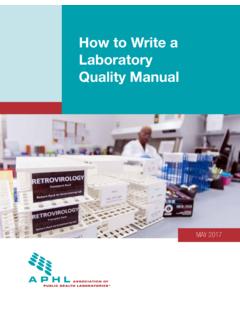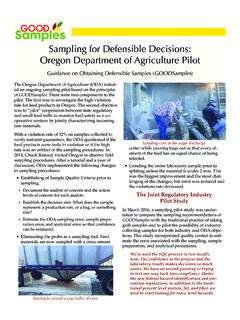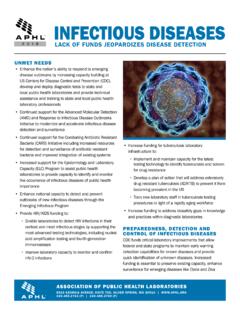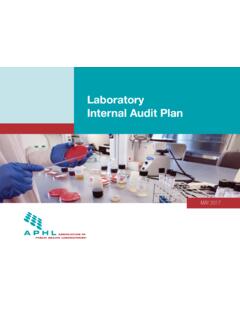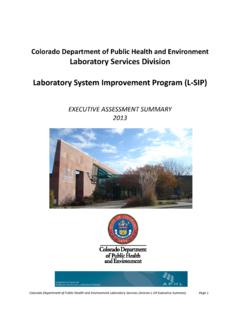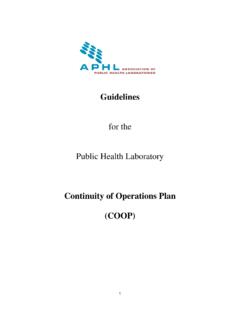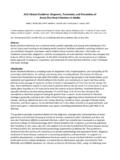Transcription of Clinical Information Epidemiology - APHL
1 Clinical InformationTrichomoniasis can cause urethritis in men and vaginitis in women, although the majority of infections are Extragenital infections ( , oral, rectal) are uncommon. Infection with T. vaginalis is associated with increased acquisition and transmission of HIV2 and other STDs3 and linked with preterm delivery of low birth weight Trichomoniasis can be cured with nitroimidazole antibiotics ( , metronidazole or tinidazole), usually in a single In addition, all sex partners of infected individuals should be treated concurrently, to prevent Although there have been infrequent reports of low level in vitro resistance to nitroimidazoles, correlation with Clinical outcomes is estimated million women and men are infected with T.
2 Vaginalis in the United Among women aged 14 49 years participating in the National Health and Examination Survey (NHANES), the prevalence of T. vaginalis infection measured by PCR was overall, and varied considerably by race: for non-Hispanic white women, for Mexican-American women, and for non-Hispanic black women. Other significant correlates of infection included increasing age, a greater number of lifetime sex partners, lower educational level, poverty, and vaginalis, a protozoan parasite, is the most prevalent non-viral sexually transmitted infection in the United States and worldwide, and the cause of the curable sexually transmitted disease (STD), trichomoniasis.
3 Available diagnostics for T. vaginalis range from basic microscopy to nucleic acid amplification assays. Considerations for laboratories include the sensitivity and specificity of each assay, as well as the cost to perform the assay. Trichomoniasis is not a reportable or nationally notifiable condition. ISSUES In BrIEf: LABorATory DETECTIon of trichomonas AUgUST 2013 Laboratory Detection of trichomonas August 20131 Diagnostic methodsThe traditional diagnostic method for trichomoniasis has been wet mount with microscopic visualization of motile T. vaginalis parasites on slide preparations from vaginal or urethral secretions. Ideally, specimens should be examined within 10 minutes to observe motile parasites, which are diagnostic.
4 Wet mount is an inexpensive diagnostic test; however, sensitivity is estimated at 51-65%, and varies based on the individual performing the test and how promptly the slide is ,9 Culture has been considered the gold standard for diagnosis of trichomoniasis with a specificity approaching 100%, but it is not widely used and its sensitivity can be as low as 75 96%.8,9 Clinical specimens can be inoculated into transport systems such as Amies gel medium to maintain viability for up to 24 hours at room Culture systems such as InPouch TV (BioMed Diagnostics, San Jose, CA) allow for direct inoculation, culture and microscopic examination. Additionally, these systems can be used to transport specimens after inoculation.
5 Such systems are useful when immediate transportation of specimens to the laboratory is not available. The specimen should be inoculated as soon as possible (within an hour of collection) to maintain viability of the organism. Neither conventional nor liquid-based Papanicolau (Pap) smears are suitable for routine screening or diagnosis of T. vaginalis, because sensitivity is poor; in addition, positive predictive value is low in settings where the prevalence of infection is The OSOM (formerly Xenostrip) trichomonas Rapid Test (Sekisui Diagnostics, Framingham, MA) is an immunochromatographic capillary-flow enzyme immunoassay dipstick test and the only rapid antigen test commercially available in the US.
6 It is performed on vaginal secretions with results available within 10 minutes. This point-of-care test is FDA-cleared for females and CLIA waived. Test specifications include sensitivity 82 95% and specificity 97 100%.8,12 The Affirm VPIII Microbial Identification Test (Becton Dickinson, Franklin Lakes, NJ) is an FDA-cleared nucleic acid probe test for the diagnosis of three causes of female vaginitis: T. vaginalis, Gardnerella vaginalis and Candida albicans. Sensitivity for T. vaginalis is 63% and specificity This is considered a same-day test as it produces results in 45 minutes; however, it is characterized as a CLIA moderate complexity test. Nucleic acid amplification tests (NAATs) are the most sensitive tests available for detection of T.
7 Vaginalis. The APTIMA trichomonas vaginalis Assay (Hologic Gen-Probe, San Diego, CA) was FDA-cleared in 2011 for use with urine, endocervical and vaginal swabs, and endocervical specimens collected in the Hologic PreserveCyt solution (ThinPrep) from females only. Sensitivity is 95 100% and specificity is also 95 100%.8, 13, 14 The BD ProbeTec trichomonas Vaginalis Qx Amplified DNA Assay (Becton Dickinson, Franklin Lakes, NJ) launched in Europe (EU cleared) in 2012, but is not FDA-cleared in the United States at this time. Diagnosis of T. vaginalis in men has been challenging given the low sensitivity of microscopy and lack of FDA clearance to date for any NAATs or point-of-care tests for use with male specimens.
8 Some laboratories have verified the performance characteristics of NAATs through a validation process for male urine specimens or penile-meatal swabs. Culture of urine, semen, and/or urethral swabs may be other diagnostic options for men. Screening and TreatmentCurrent recommendations for T. vaginalis testing and screening, along with detailed Clinical treatment recommendations, can be found in CDC s STD Treatment Guidelines, available online at: PubLic heaLth Laboratory issues in brief2 Diagnostic TestTechniqueTime to ResultSpecimenSensitivitySpecificityComm entsWet mountMicroscopic visualizationMinutesVaginal or urethral discharge51 65%up to 100%Inexpensive; technician-dependentCultureCulture media24 120 hoursVaginal or urethral swab75 96%up to 100%Considered diagnostic gold standard in the pastOSOM trichomonas Rapid TestImmunochrom atographic capillary-flow enzyme immunoassay dipstick 10 minutesVaginal swabs or saline for wet mount82 95%97 100%CLIA-waived for females.
9 Can be used at the point-of-careAffirm VPIII Microbial Identification TestNucleic acid probe test45 minutesVaginal swabs63% complex same-day test; FDA-cleared for use with specimens from females; also detects Gardnerella vaginalis and Candida albicansAPTIMA trichomonas vaginalis AssayTranscription Mediated Amplification (TMA)HoursUrine specimens, endocervical and vaginal swabs, and specimens collected in PreservCyt Solution95 100%95 100%NAATs are the most sensitive tests; FDA-cleared for use with specimens from symptomatic or asymptomatic femalesBD ProbeTec trichomonas vaginalis Qx Amplified DNA AssayStrand Displacement Amplification (SDA)HoursNot an FDA-cleared productVariety of female specimens have been testedPCRP olymerase Chain ReactionHoursNo FDA-cleared kitVariety of male and female specimens have been tested*Ranges of sensitivities and specificities were summarized for multiple specimen types and include comparisons to multiple methods, based on published data ( , unpublished data from package inserts were not included).
10 Table 1: overview and characteristics of diagnostic assays for trichomonas vaginalis*Laboratory Detection of trichomonas August 20133 trichomonas vaginalis Testing in Public health Laboratories, 2010 The Association of Public Health Laboratories and the Centers for Disease Prevention and Control fielded an online survey in 2011 to characterize the role of public health laboratories (PHLs) in STD prevention. The objective of this survey was to determine current STD testing capabilities and capacities of state and local PHLs over the period of January 1, 2010 December 31, 2010. The survey aimed to gather data from 96 state and local public health laboratories within the United States on overall capacities and capabilities as well disease-specific Information .
